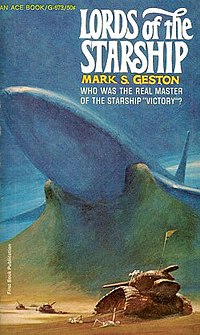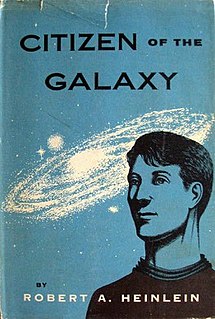
Citizen of the Galaxy is a science fiction novel by American writer Robert A. Heinlein, originally serialized in Astounding Science Fiction and published in hardcover in 1957 as one of the Heinlein juveniles by Scribner's. The story is heavily influenced by Rudyard Kipling's Kim.

Orphans of the Sky is a science fiction novel by American writer Robert A. Heinlein, consisting of two parts: "Universe" and its sequel, "Common Sense". The two novellas were first published together in book form in 1963. "Universe" was also published separately in 1951 as a 10¢ Dell paperback. The work presents one of the earliest fictional depictions of a generation ship.
The Heechee Saga, also known as the Gateway series, is a series of science fiction novels and short stories by Frederik Pohl. The Heechee are an advanced alien race that visited the Solar System hundreds of millennia ago and then mysteriously disappeared. They left behind bases containing artifacts, including working starships, which are discovered and exploited by humanity.

Galaxy Science Fiction was an American digest-size science fiction magazine, published in Boston from 1950 to 1980. It was founded by a French-Italian company, World Editions, which was looking to break into the American market. World Editions hired as editor H. L. Gold, who rapidly made Galaxy the leading science fiction magazine of its time, focusing on stories about social issues rather than technology.
"Where no man has gone before" is a phrase made popular through its use in the title sequence of the original 1966–1969 Star Trek science fiction television series, describing the mission of the starship Enterprise. The complete introductory speech, spoken by William Shatner as Captain James T. Kirk at the beginning of each episode, is:
Space: the final frontier. These are the voyages of the starship Enterprise. Its five-year mission: to explore strange new worlds. To seek out new life and new civilizations. To boldly go where no man has gone before!
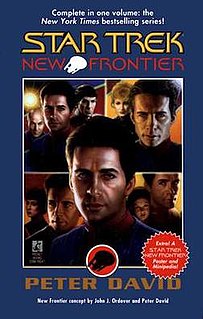
Star Trek: New Frontier is a series of interlinked novels written by Peter David, published by Simon & Schuster imprints, Pocket Books, Pocket Star, and Gallery Books, from 1997 to 2015. New Frontier was the first Star Trek tie-in fiction property not to be based on a television series. The series was created by John J. Ordover.

Redemption Ark is a 2002 science fiction novel by Welsh author Alastair Reynolds set in the Revelation Space universe. It continues the story of Nevil Clavain begun in the short stories "Great Wall of Mars" and "Glacial".

Non-Stop is a 1958 science fiction novel by British writer Brian Aldiss. It is about problems that the inhabitants of a huge generation space ship face after an alien amino acid that they picked up on another planet triggers a pandemic. Law and order began to collapse, and knowledge of the ship and its purpose was eventually almost entirely lost throughout the vessel.
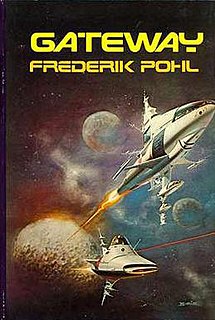
Gateway is a 1977 science fiction novel by American writer Frederik Pohl. It is the opening novel in the Heechee saga, with four sequels that followed. Gateway won the 1978 Hugo Award for Best Novel, the 1978 Locus Award for Best Novel, the 1977 Nebula Award for Best Novel, and the 1978 John W. Campbell Memorial Award for Best Science Fiction Novel. The novel was adapted into a computer game in 1992.
Mark Symington Geston is an American science fiction and fantasy author.

Alternate Realities is a 2000 omnibus collection of three short science fiction novels by American writer author C. J. Cherryh: Wave Without a Shore (1981), Port Eternity (1982), and Voyager in Night (1984). All three novels are set in Cherryh's Alliance-Union universe and share a common theme of people encountering and coping with a reality different from their own.
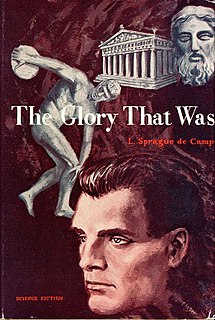
The Glory That Was is a science fiction novel by American writer L. Sprague de Camp. It was first published in the science fiction magazine Startling Stories for April, 1952, and subsequently published in book form in hardcover by Avalon Books in 1960 and in paperback by Paperback Library in March 1971. It has since been reprinted in paperback by Ace Books in July 1979 and Baen Books in April 1992, and in trade paperback by Phoenix Pick in September 2014. An E-book edition was published by Gollancz's SF Gateway imprint on September 29, 2011 as part of a general release of de Camp's works in electronic form; a second e-book edition was issued by Phoenix Pick in September 2014. The book has also been translated into Italian, German and Greek.

The Psychotechnic League is a future history created by American science fiction writer Poul Anderson. The name "Psychotechnic League" was coined by Sandra Miesel in the early 1980s, to capitalize on Anderson's better-known Polesotechnic League future history. Anderson published 21 novels, novellas and short stories set in this future between 1949 and 1957, with a 22nd published in 1968.
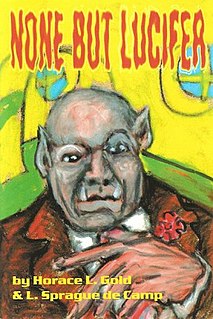
None but Lucifer is a fantasy novel by American writers Horace L. Gold and L. Sprague de Camp. It was first published in the fantasy magazine Unknown in September 1939, and later serialized in the revival of Galaxy Science Fiction, March-July 1994. Despite its good reception by the readership and the prominence of its authors, the book remained unpublished in book form for over sixty years, until finally issued as a trade paperback by Gateways Retro Science Fiction in 2002. It is also available as an electronic publication.
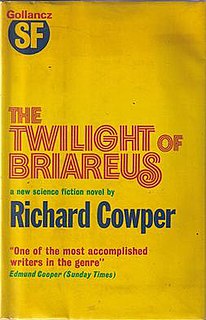
The Twilight of Briareus is a science-fiction novel by John Middleton Murry Jr., under his pseudonym Richard Cowper. It "combine[s] disaster and invasion themes". One critic sees it as the book that Cowper's other novels resemble at heart.

Ancillary Justice is a science fiction novel by the American writer Ann Leckie, published in 2013. It is Leckie's debut novel and the first in her Imperial Radch space opera trilogy, followed by Ancillary Sword (2014) and Ancillary Mercy (2015). The novel follows Breq—who is both the sole survivor of a starship destroyed by treachery and the vessel of that ship's artificial consciousness—as she seeks revenge against the ruler of her civilization. The cover art is by John Harris.

The Haunted Stars is a science fiction novel by American writer Edmond Hamilton. It tells the story of an expedition from Earth to a planet of the star Altair — a planet called Ryn, inhabited by humans like those on Earth. Against the wishes of Ryn's inhabitants, the team from Earth seek information about weapons technology used in an ancient space war. Their unsuccessful search ends in dramatic contact with another species, the ancient enemy of Ryn.
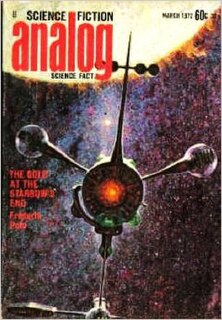
"The Gold at the Starbow's End" is a science fiction novella by American writer Frederik Pohl. Originally published in the March 1972 issue of Analog Science Fiction/Science Fact, it was nominated for both the 1973 Hugo Award for Best Novella and the 1973 Nebula Award for Best Novella. It did win the 1973 Locus Award for Best Novella.
Douglas Adams's Starship Titanic is a novel written by Terry Jones, based on the game Starship Titanic conceived by Douglas Adams. The novel was published in October 1997 by Harmony Books and Pan Books, and in November 1998 by Ballantine Books.

Davidé Fabbri is a comic book artist. He has worked mainly for Dark Horse Comics on various Star Wars series. Also worked for Dynamite and recently for DC Comics. In 2010, he worked on Victorian Undead, written by Ian Edginton for Wildstorm. This series pitted Sherlock Holmes and Dr Watson against a legion of undead zombies. It was nominated for a Rondo Hatton Classic Horror Awards in 2010.
